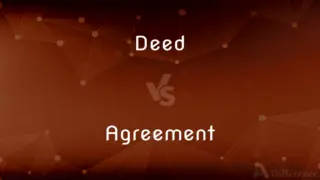Ductile Iron vs. Cast Iron — What's the Difference?
By Fiza Rafique & Maham Liaqat — Published on August 14, 2024
Ductile iron offers superior tensile strength and flexibility, while cast iron is known for its excellent wear resistance and hardness.

Difference Between Ductile Iron and Cast Iron
Table of Contents
ADVERTISEMENT
Key Differences
Ductile iron, also known as nodular cast iron, is characterized by its high tensile strength and ductility, resulting from the addition of magnesium to the alloy. This process creates spherical graphite structures, enhancing its ability to withstand stress without fracturing. Cast iron, on the other hand, is a group of iron-carbon alloys with a carbon content greater than 2%, known for its good fluidity, castability, excellent machinability, wear resistance, and exceptional damping properties. Its graphite structure is flake-like, contributing to its brittleness.
While ductile iron is used for parts requiring high strength and flexibility, such as water and sewer pipes, automotive components, and machinery parts, cast iron is preferred for its stability under heat, making it ideal for engine blocks, cookware, and brake rotors. The spherical graphite in ductile iron provides better shock absorption capabilities compared to the flake graphite of cast iron, which has superior wear resistance.
Ductile iron's adaptability under load makes it a preferred choice for dynamic and high-stress applications, where deformation resistance is critical. Cast iron, with its inherent brittleness and excellent wear resistance, is more suited for applications where the material must resist deformation under load, such as in heavy-duty machinery bases and frames.
The production of ductile iron involves a more controlled process, including the addition of magnesium, which results in higher production costs compared to traditional cast iron. This makes cast iron a more economical option for applications where the superior mechanical properties of ductile iron are not required.
In terms of corrosion resistance, ductile iron generally offers better performance than standard cast iron, thanks to its microstructural components. However, both materials can be further enhanced through various surface treatments and alloying to improve their resistance to corrosive environments.
ADVERTISEMENT
Comparison Chart
Composition
Iron, carbon, silicon, magnesium
Iron, carbon (usually 2-4%), silicon
Graphite Structure
Spherical
Flake-like
Tensile Strength
High
Lower than ductile iron
Ductility
High
Low
Wear Resistance
Good
Excellent
Applications
Pipes, automotive components, machinery parts
Engine blocks, cookware, brake rotors
Production Cost
Higher due to the magnesium addition process
Lower, traditional manufacturing process
Corrosion Resistance
Generally better than cast iron
Varies, but can be improved with treatments
Compare with Definitions
Ductile Iron
High Tensile Strength
Ductile iron's high tensile strength makes it suitable for water pipes that can withstand underground stresses.
Cast Iron
Excellent Wear Resistance
Cast iron's wear resistance makes it perfect for brake rotors that endure frequent friction.
Ductile Iron
Spherical Graphite Structure
The spherical graphite in ductile iron contributes to its flexibility and shock absorption.
Cast Iron
Good Fluidity and Castability
Cast iron's fluidity makes it easy to cast into complex shapes like engine blocks.
Ductile Iron
Enhanced Ductility
Ductile iron can be bent, twisted, or deformed without breaking, ideal for dynamic applications.
Cast Iron
Flake Graphite Structure
The flake graphite in cast iron contributes to its brittleness but excellent damping properties.
Ductile Iron
Magnesium Treatment
The addition of magnesium in ductile iron production creates its distinctive spherical graphite.
Cast Iron
Superior Machinability
The flake graphite in cast iron provides natural lubrication, making it easier to machine.
Ductile Iron
Shock Absorption
Ductile iron's structure allows it to absorb shock better, protecting automotive components in crashes.
Cast Iron
Thermal Stability
Cast iron's stability under heat makes it ideal for cookware that can withstand and distribute high temperatures evenly.
Cast Iron
Made of cast iron.
Cast Iron
Exceptionally strong or resistant
A cast-iron stomach.
Cast Iron
Alternative spelling of cast iron
Cast Iron
Made of cast iron. Hence, Fig.: like cast iron; hardy; unyielding.
Cast Iron
Extremely robust;
An iron constitution
Common Curiosities
What makes ductile iron different from cast iron?
Ductile iron has higher tensile strength and ductility due to its spherical graphite structure, unlike cast iron's flake graphite which makes it more brittle.
Can ductile iron be used in place of cast iron?
Yes, in many applications, especially where higher strength and flexibility are required, though cost differences may be a consideration.
Why is cast iron preferred for cookware?
Its excellent heat retention and distribution, coupled with wear resistance, make it ideal for cooking applications.
Is ductile iron more expensive than cast iron?
Generally, yes, due to the additional processing and materials (like magnesium) required to produce it.
Which is more corrosion resistant, ductile or cast iron?
Ductile iron typically offers better corrosion resistance, but both can be treated to improve their resistance to rust and corrosion.
Can the machinability of cast iron be considered an advantage?
Yes, the inherent lubrication provided by its graphite flakes makes it easier to machine, reducing wear on tools.
Why is ductile iron better for dynamic applications?
Its high ductility and shock absorption capabilities make it better suited to withstand stresses in dynamic environments.
Why is cast iron considered good for damping properties?
Its flake graphite structure efficiently absorbs and dissipates vibrational energy, making it ideal for machinery bases.
How does the graphite structure affect the properties of these irons?
The spherical graphite in ductile iron enhances its strength and flexibility, while the flake graphite in cast iron contributes to its brittleness and wear resistance.
Can the properties of ductile and cast iron be altered?
Yes, through alloying, heat treatment, and surface treatments, the properties of both materials can be modified for specific applications.
What applications require the use of ductile iron over cast iron?
Applications requiring higher tensile strength, flexibility, and shock resistance, like automotive parts and water pipelines.
How do I choose between ductile iron and cast iron for a project?
Consider the mechanical properties required (such as strength, ductility, wear resistance), the application environment, and cost.
How do production costs compare between ductile and cast iron?
Ductile iron typically has higher production costs due to the magnesium addition and controlled process required for its manufacture.
What advancements have been made in the production of ductile and cast iron?
Technological advancements have improved the quality, consistency, and range of properties for both types of iron, expanding their application range.
Is one type of iron more environmentally friendly than the other?
The environmental impact depends more on the production methods and recycling practices than on the type of iron itself.
Share Your Discovery

Previous Comparison
Deed vs. Agreement
Next Comparison
BB Cream vs. CC CreamAuthor Spotlight
Written by
Fiza RafiqueFiza Rafique is a skilled content writer at AskDifference.com, where she meticulously refines and enhances written pieces. Drawing from her vast editorial expertise, Fiza ensures clarity, accuracy, and precision in every article. Passionate about language, she continually seeks to elevate the quality of content for readers worldwide.
Co-written by
Maham Liaqat












































